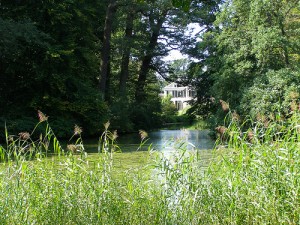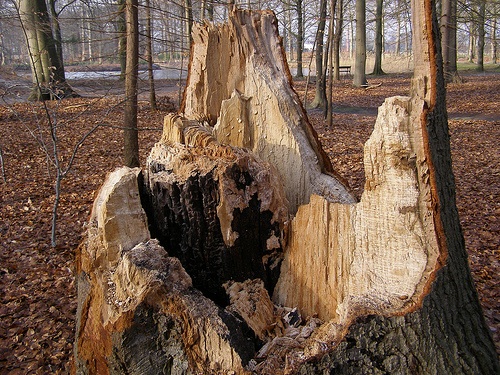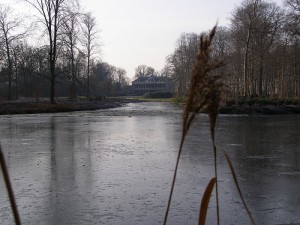Schaep en Burgh, the most northern of the estates in ‘s-Graveland, is currently being restored by its owner Natuurmonumenten.  The estate, which originated in the 17th century, had been remodeled in 1818 into a landscape garden by architect J. D. Zocher Jr. Natuurmonumenten are now using a map from around 1820 as a guideline for their restoration. 1I have not yet been able to trace that map down, I will post that when I have found it. The map is found in the Wijdemeren archive. Research was done by SB4. The work is the first step of an extensive revitalisation plan by Natuurmonumenten. Apart from Schaep en Burgh, they will also start work on the other 9 estates they own in ‘s-Graveland.
The estate, which originated in the 17th century, had been remodeled in 1818 into a landscape garden by architect J. D. Zocher Jr. Natuurmonumenten are now using a map from around 1820 as a guideline for their restoration. 1I have not yet been able to trace that map down, I will post that when I have found it. The map is found in the Wijdemeren archive. Research was done by SB4. The work is the first step of an extensive revitalisation plan by Natuurmonumenten. Apart from Schaep en Burgh, they will also start work on the other 9 estates they own in ‘s-Graveland.
The work that has taken place in November and December 2008 focusses on the hook-shaped pond that Zocher designed just behind the house, the so-called ‘Lindenkom’. A photo taken in September 2008 shows how overgrown the area around the pond had become. Views over the pond, originally intended by Zocher, were blocked by undergrowth which was sometimes intentionally planted in the 190 years since the original design was made. A path running along the banks of the pond was barely visible and consequently barely used, I noticed during my visit in September 2008.
This photo made earlier this month shows the current situation. The trees on the island (in the shade on the right side of the picture) are all cleared and replaced by new planting. The banks along large portions of the pond are also cleared. New shrubs are planted and several species of trees replace the cut down trees. 2Among usual suspects as beech, oak and Populus nigra ‘Italica’, they also planted specimens of the Paper Birch (Betula papyrifera), which seems a bit out of tune. But I’m happy to be surprised by the result. The view at the house, and other important vistas, are open again.
As far as I can tell from my winterly visit, they have overdone the planting of shrubs around the pond a bit. The plan boasts the planting of 1600 plants, but they are planted frightingly close together. In my view, Natuurmonumenten has been a bit too eager to create a ‘voluptuous’ shrubbery in too short a time.
This eagerness may have been insprired by criticism on the work they are doing. In November 2008 objections were raised against the extensive clearing of trees and shrubs in the garden. Apart from the architectural and historical arguments -which in my view speak in favour of this restoration- the critics must not have realised that the abundance of mature beech trees in the garden would have posed a problem of increasing proportions in the near future, as they seem to have reached the point that they fall down without warning already. The work started with the clearing of two beech trees right next to the house, which were suffering major fungus infections. Beech trees have been falling apart in the whole area the past years, like a 260 year old specimen at Gooilust in April 2008 and one just behind the Lindenkom at Schaep en Burgh in the past months (photo), which only appears to have damaged a neighbouring tree in its fall. 3Regional paper Gooi en Eemlander reported on the Gooilust beech tree on 22 April 2008, but the report is not available on their website anymore.

The stump of a recently broken beech tree at Schaep en Burgh, caused by a fungus infection. The ‘Lindenkom’ is visible in the background. Photos by HvdE.
Beech trees (in The Netherlands) have a lifespan of 200-300 years, when they are happy with their designated location. Trees in gardens are not always planted on favourable spots as far as life span is concerned. I believe people who care about parks and gardens -in their neighbourhood or in general- must prepare for a clearing of beech trees on a large scale in the upcoming decades, because they have been used abundantly in early 19th century landscape gardens throughout the country. I just hope they will be replaced with a good idea in mind, either by a modern layout, or a as the result of a restoration or revitalisation plan as is the case here.
Footnotes
| ↑1 | I have not yet been able to trace that map down, I will post that when I have found it. The map is found in the Wijdemeren archive. Research was done by SB4. |
|---|---|
| ↑2 | Among usual suspects as beech, oak and Populus nigra ‘Italica’, they also planted specimens of the Paper Birch (Betula papyrifera), which seems a bit out of tune. But I’m happy to be surprised by the result. |
| ↑3 | Regional paper Gooi en Eemlander reported on the Gooilust beech tree on 22 April 2008, but the report is not available on their website anymore. |




hi Henk,
I was told this map was found in archives of municipality Wijdemeren ; research done by SB4
cheers
Jan
Hi Jan,
Thanks for pointing that out!
I think the info on the whereabouts of the map is also in one of the links, but it is better to put it up here. Also mentioning the research done by SB4 is welcome info.
A trip to the Wijdemeren archive needs to be planned soon.